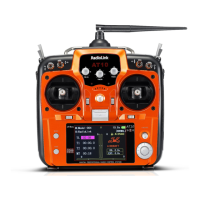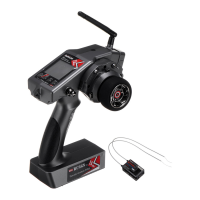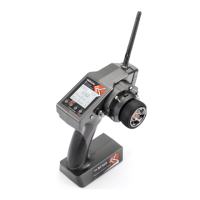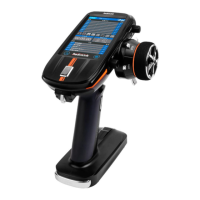24
MODEL TYPE
: sets the type of programming used for this model.
The AT10 has 15 model memories, which can each support:
•one powered aircraft (
ACRO
PHPRU\ W\SH ZLWKPXOWLSOH ZLQJ DQGWDLO FRQ¿JXUDWLRQV 6HHWZLQ DLOHURQ VHUYRV WZLQ
elevator servos,
ELEVON
, and
V-TAIL
for further information.);
WKUHHJOLGHUZLQJW\SHVDJDLQZLWKPXOWLSOHWDLOFRQ¿JXUDWLRQV6HH*OLGHU
MODEL TYPE
for details, p. 61;
•eight helicopter swashplate types, including CCPM. See Helicopter
MODEL TYPE
for details, p. 73.
%HIRUHGRLQJDQ\WKLQJHOVHWRVHWXS\RXUDLUFUDIW¿UVW\RXPXVWGHFLGHZKLFK
MODEL TYPE
EHVW¿WVWKLVSDUWLFXODUDLUFUDIW
(Each model memory may be set to a different model type.) If your transmitter is a AT10, the default is
ACRO
. If it is a
AT10, the default is
HELI(H1)
.
ACRO
is the best choice for most powered airplanes, but in some circumstances,
GLID(2A+1F)
may be a better choice.
ACRO
is usually a better choice because of functions it offers that the
GLID
types do not:
•
ACRO
adds:
•
SNAP-ROLL
•
AILEVATOR
(twin elevator servo support)
•For fuel-powered airplanes:
IDLE-DOWN
,
THR-CUT
,
THROTTLE-NEEDLE
mixing and
THROTTLE DELAY
programming.
•But
ACRO
lacks:
•5 seperate conditions for optional setups (
START
SPEED
DISTANCE
LANDING
)
If you are using a glider or heli
MODEL TYPE
, please go to that chapter now to select the proper model type and support
your model setup. Note that changing
MODEL TYPE
resets all data for the model memory, including its name.
GOAL of EXAMPLE: STEPS: INPUTS:
Select the proper
MODEL TYPE
for your
model. Ex:
ACRO
.
[NOTE: This is one of several functions
that requires confirmation to make a
change. Only critical changes require
additional keystrokes to accept the
change.]
Open the
BASIC
menu, then open the
PARAMETER
submenu.
Turn on the transmitter.
for 1 second.
(If
ADVANCE
, again.)
then
C
to highlight
PARAMETER
.
to choose
PARAMETER
.
Go to
MODEL TYPE
.
C
to
TYPE
.
Select proper
MODEL TYPE
.
Ex:
ACRO
.
&RQ¿UPWKHFKDQJH
Close
PARAMETER
.
to
ACROBATIC
. for 1 second.
Are you sure?
displays.
WRFRQ¿UP
to return to
BASIC
menu.
Adjustable travel limit (
ATL
): makes the channel 3 TRIM LEVER (THROTTLE TRIM) effective only at low throttle,
disabling the trim at high throttle. This prevents pushrod jamming due to idling trim changes. This function defaults to
ON
.
If you are not using channel 3 for throttle, you may want trim operation the same as on all other channels. To do so, set
ATL
to
OFF
. If you need the
ATL
to be effective at the top of the stick instead of the bottom, reverse the
THR-REV
setting. Note
that this affects all models in the radio, not just the model you are currently editing. See servo
REVERSE
, p. 26.
Second aileron (
AILE-2
) (
ACRO
GLID 1A+1F
GLID 2A+1F
only): changes the default choice for dual aileron servos from
channels 6 (
FLAPERON
) to channels 5 and 6, or 7(
AIL-DIF
) to channels 5 and 7. This allows you to utilize these 2 great
functions while utilizing a 5-channel receiver.
NOTE: Changing
AILE-2
only tells the system which servos to utilize if
FLAPERON
or
AIL-DIF
is activated. You still must
activate that function and complete its setup. For details on twin aileron servos, including using
AILE-2
, see p. 42.

